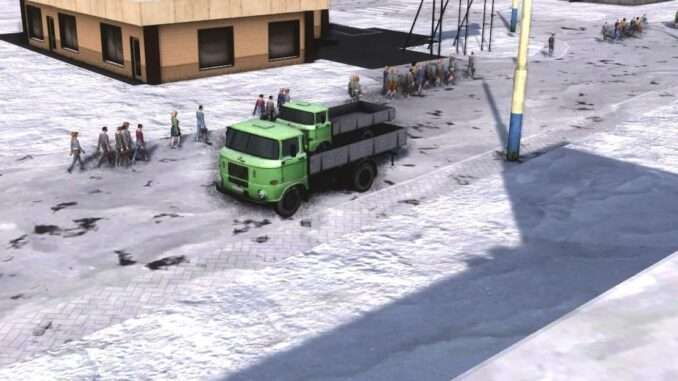
This guide is a massive detailed breakdown of the traffic signs that got added with Update #10 (0.8.7.8). It describes how each traffic sign works and the underlying traffic logic. I further added a bunch of examples of what one can do with the system. This guide assumes basic knowledge of Workers & Resources: Soviet Republics, and also just a common sense understanding how traffic works in real life.
Overview
How to use
First of course, Complex Traffic needs to be enabled in the gameplay options, either when starting a new map or during a running game. There’s really no noticeable downside even when activated. Even if activated, it still remains an optional choice on how much you want to engage with it.
All the current signs

These signs can be split essentially into two categories:
- Regulatory signs
- Zones
- Priority Signs & Traffic Lights
All the road signs can be found under the waypoint in the Roads / Streets category.

Regulatory signs and Zone signs are both placed on the road. Priority signs and Traffic lights are placed on (or activated on) intersections.
Regulatory Signs


Regulatory signs are signs you put on the side of the road, which passing vehicles are forced to abide by, or prohibits them from passing in the first place (more about individual vehicle traffic logic further down below). Most of the signs are self-explanatory with common sense and a basic understanding of real world traffic laws, but I’ll still explain each single one of them.
Regulatory Signs I would group into two categories, I just made up;
- Segment Signs
- Restriction Signs
Signs need at least a gravel road or better, and can’t be placed on mud roads.
Two signs can be placed on top of each other. If for any reason you need more signs, you have to space them out. Further, placing one sign might overwrite another one. Placing a “No Motor Vehicles” sign on top of a “No Buses” sign, will simply overwrite the “No Buses”.
Hypothetical example of a village’s gravel road leading onto a bigger asphalt road:
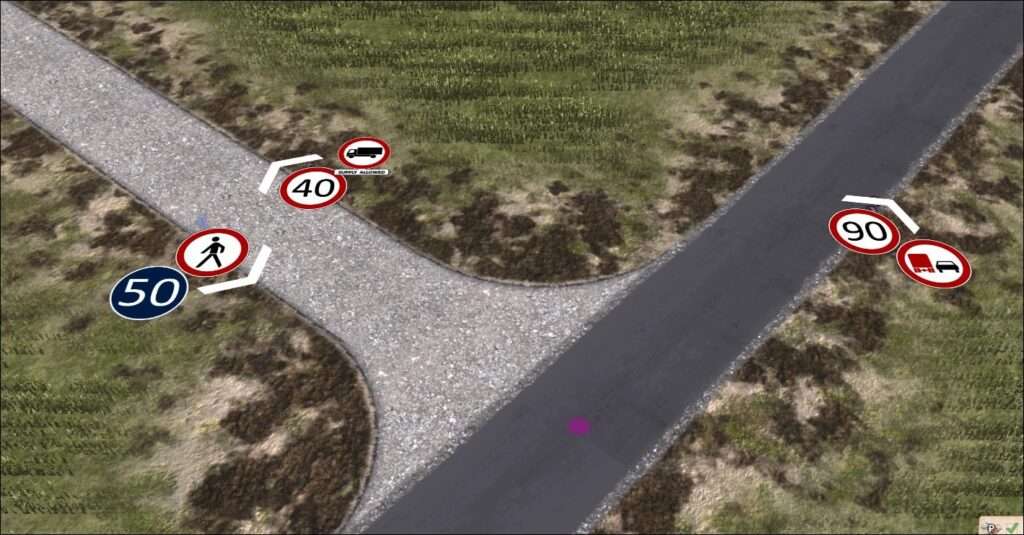
The asphalt road has a speed limit of 90km/h and heavy trucks are banned from overtaking.
The gravel road has a speed limit of 40km/h, and only trucks that bring supplies are allowed passed.
Pedestrians are not allowed onto the asphalt road, and vehicles wanting to go onto the asphalt road need to be capable of at leeast driving 50km/h.
Segment Signs
Segment signs apply to the vehicle as soon as they pass the sign, and remain in effect for the remaining road segment.
However, this also means that a sign’s rule is only being applied until the next node, as such these signs are only useful for longer road segments, and need to be “re-applied” for each road segment.

Maximum Speed



Maximum Speed signs enforce a speed limit on any vehicle that passes by. They can be used to make certain roads less attractive, enforce a more uniform speed by slowing down speedsters, or role-playing purposes.
The maximum speed can be increased and decreased by pressing E/Q (or whatever increase/decrease bridge height is bound to).
No Overtaking


Vehicles are disallowed from overtaking any other vehicle. There’s two versions of this sign: One that bans all overtaking of any vehicle by any vehicle, and one that only bans heavy vehicles from overtaking, but still allows smaller cars and similar to overtake slower vehicles.
This sign is useful to stop accordion effects from happening, where one vehicle (tries to) overtake someone else, forcing either the vehicle being overtook or one behind them to come to a full stop, which forces a following vehicle to also come to a full stop, causing a rippling effect for a bunch of vehicles and causing a small traffic jam.
End of Restrictions

Revert to default speed limit and allows vehicles to overtake each other.
Restriction Signs
Restriction signs are very straightforward; if you’re not allowed to enter, you’re not allowed to enter. And the republic’s glorious remote-controlled autonomous GPS drone vehicles both obey all the rules, and know what’s ahead of them.
This means both of these roads have the same result:
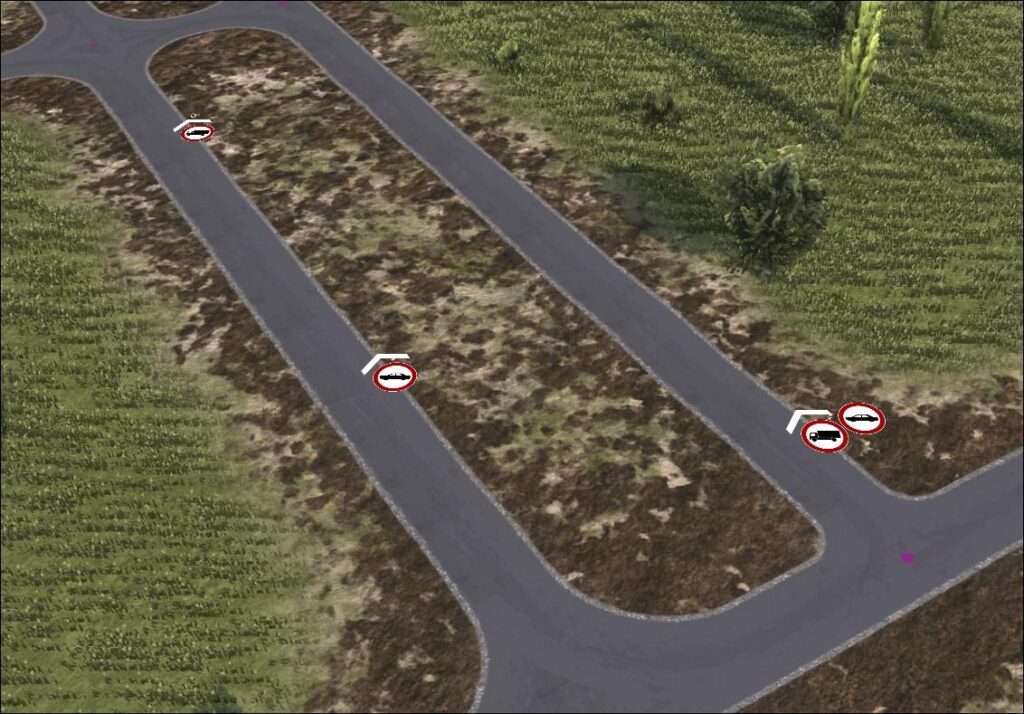
So while realistically restriction signs are at the crossroad and entrance of a street, in the game you can place it anywhere on the segment. There some are special exceptions for these rules, which I’ll go into at end of this section.
No Agricultural Vehicles

Restricts all agricultural vehicles from passing; this means harvesting vehicles and tractors.
No Heavy Goods Vehicles

Restricts all heavy goods vehicles. This means any large open or closed truck, dumper, tanker and so on. Private cars, buses and so on are allowed to pass.
No Vehicles Pulling Trailers

Restricts all vehicles that carry some form of trailer, irrelevant of type. This means for example, the LZ 100 is allowed, but LZ 100 (trailer) and LZ 100 (semi-trailer) are both banned. Bendy-Buses are also banned.
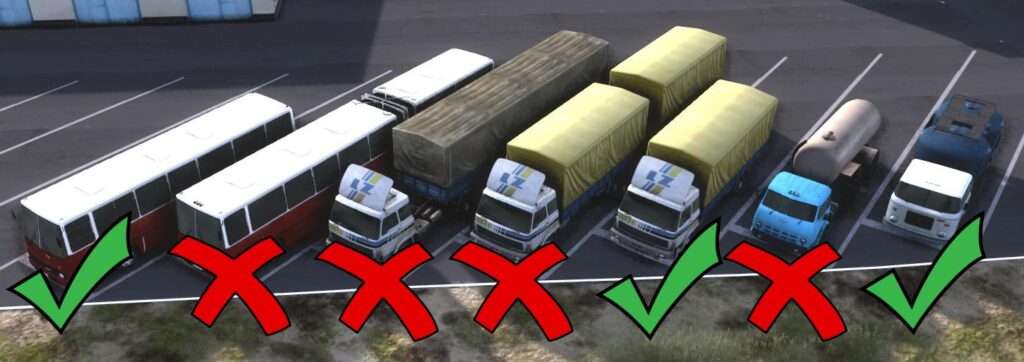
No Personal Cars

Restricts all personal cars.
No Buses

Restricts all buses.
No Pedestrians

Bans pedestrians from the road. Unless some very specific situation where for some reason you wanna ban people to walk somewhere, this is primarily for role-playing purposes, so pedestrians won’t walk across your highway intersection.
No Vehicles Except Supply


These work like their standard counter-part. However, they allow vehicles that need access, to access.
Or to rephrase, trucks will try to avoid passing by this sign, unless they have to.
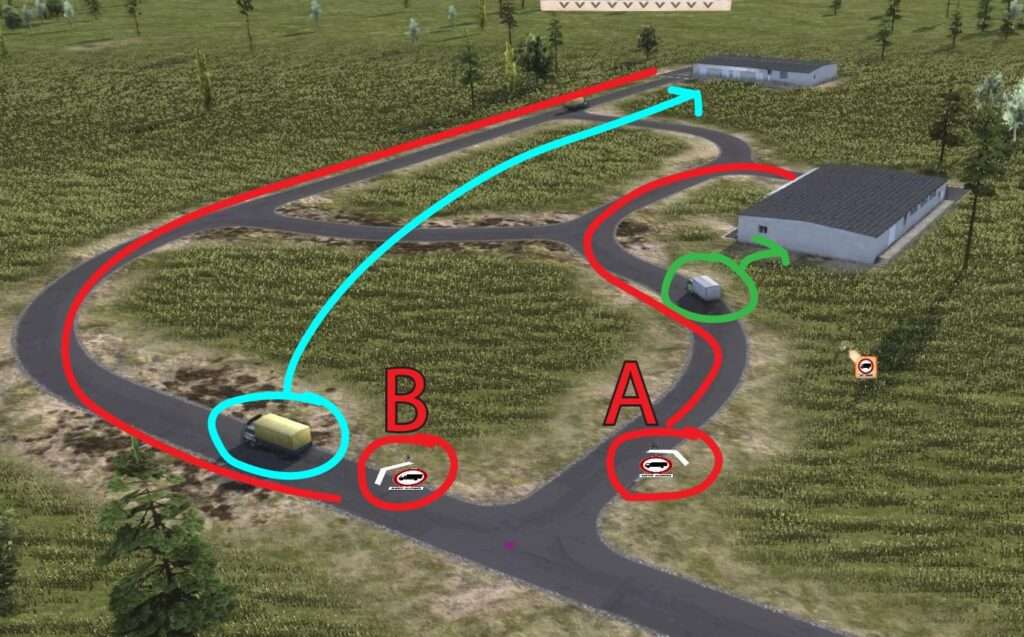
In this example, the W50 needs to head for the closer storage (green), while the LZ 100 heads to the further one (cyan). The W50 is allowed through the sign A, because the storage is directly behind, as such he’s considered to be “supplying”.
The LZ 100 is not allowed past sign A because the cyan storage is further away, even tho taking that road would be the faster route. So he has to take a different route. Sign B is also technically restricting access, but there’s no other path to take, so he’s considered supply and the sign allows him past (more on traffic logic further down).
Weight Limit



Only allows vehicles that are below the designated weight. Takes into account current weight, not empty weight.

Can be decreased or increased with Q/E. The direct use I’ve found thus far is very limited and esoteric; it seems primarily for role-playing purpose (e.g. designate maximum weight for certain bridges). But perhaps one could find a use for it in very specific and unique situations, such as filtering out vehicles with cargo and those without.
Minimum Speed Limit


Only allows vehicles to pass, that currently have the capabilities to reach this speed. This means vehicles that are too slow because they’re too old or too heavy or too full aren’t allowed passed. A use for this is to keep busy highways free of slow moving vehicles that would slow down traffic.
Can be decreased or increased with Q/E.
No Motor Vehicles

Restricts any normal vehicle, this includes normal trucks, buses, personal cars and so on. Apart from just banning any normal vehicle from the street, could potentially be used to designate a street “pedestrian only”, or to temporarily block off a road. However, the usual exceptions apply, see below.
Exceptions
Certain vehicles are completely exempt from following all or certain rules. This means they are allowed passed the No Motor Vehicles sign for example.
- Emergency vehicles, like fire trucks and ambulances, ignore all traffic signs.
- Utility vehicles, like Secret Police cars and technical service trucks (water, sewage, snowplows) ignore all restrictions, but do abide by speed limits and overtake rules.
- Very small trucks, like the B1000 truck, or the Mcar 25, or the IMV 22, in general any truck or utility vehicle (e.g. roller) that’s less than 2t ignores all restrictions, but still abides by speed limits and overtake rules. However the one restriction they do still follow is the minimum speed restriction; so the only thing you can ban the Mcar 25 from is your highway.
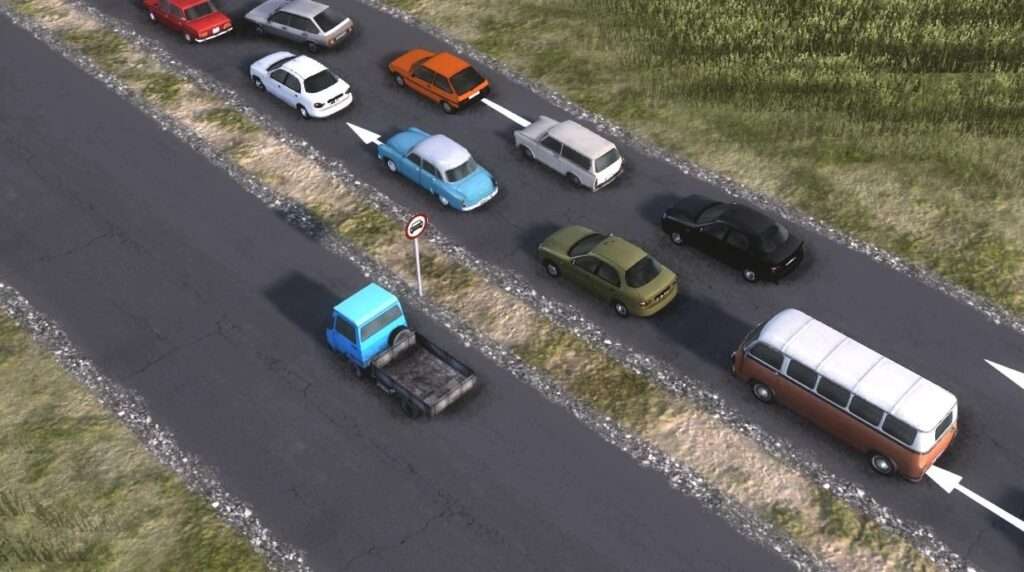
Multicar gives zero ♥♥♥ about your laws.
Zones



As mentioned in the Segmented Signs section, normal speed limit signs only apply to the current segment, and get forgotten by the next intersection or node.

Placing a normal speed limit sign in this kind of street is somewhere between impossible and pointless. But exactly for this there are zones.

Zones apply their speed limit to all the streets they encompass.
For them to work, the area needs to be properly enclosed.
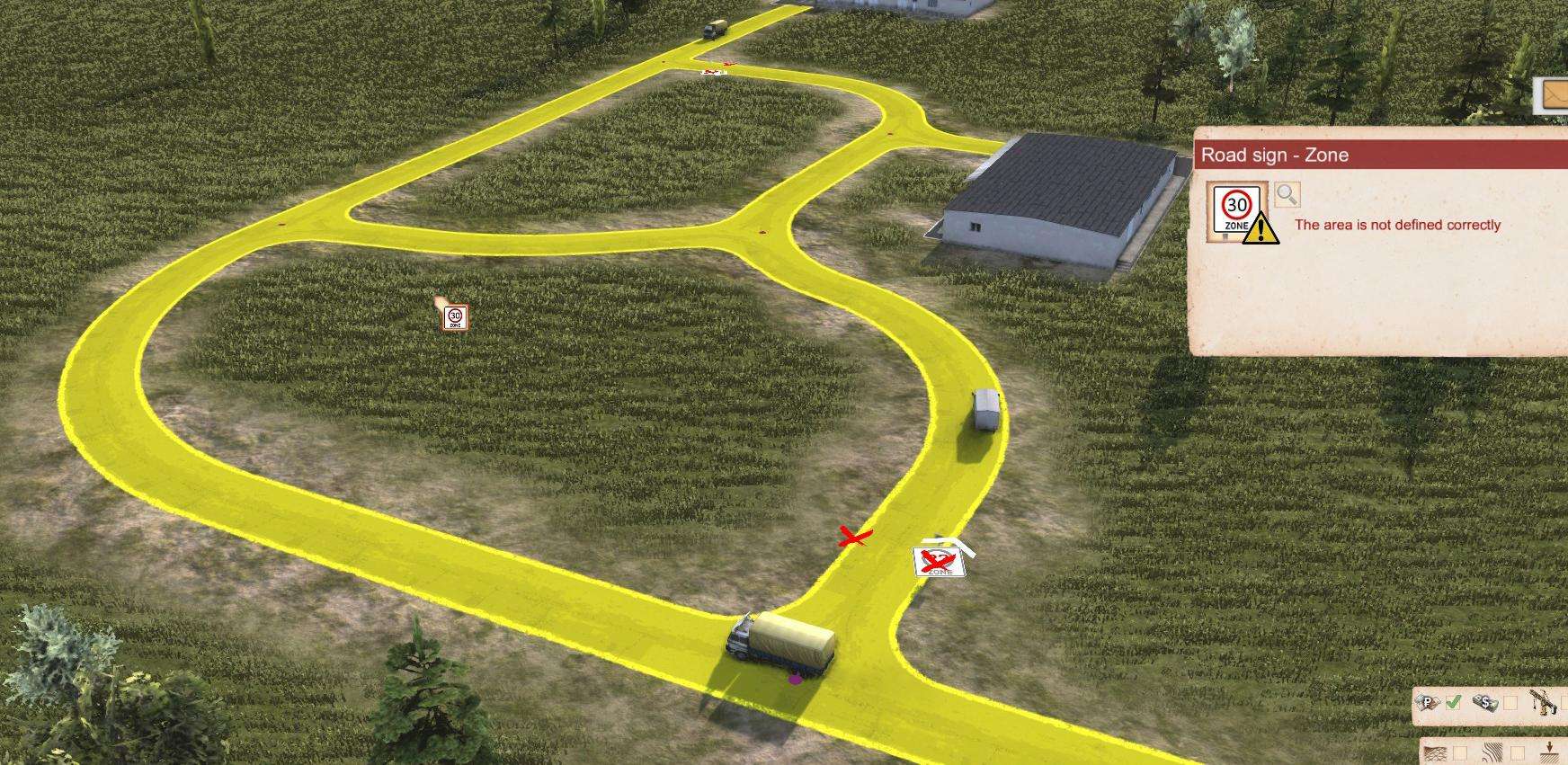
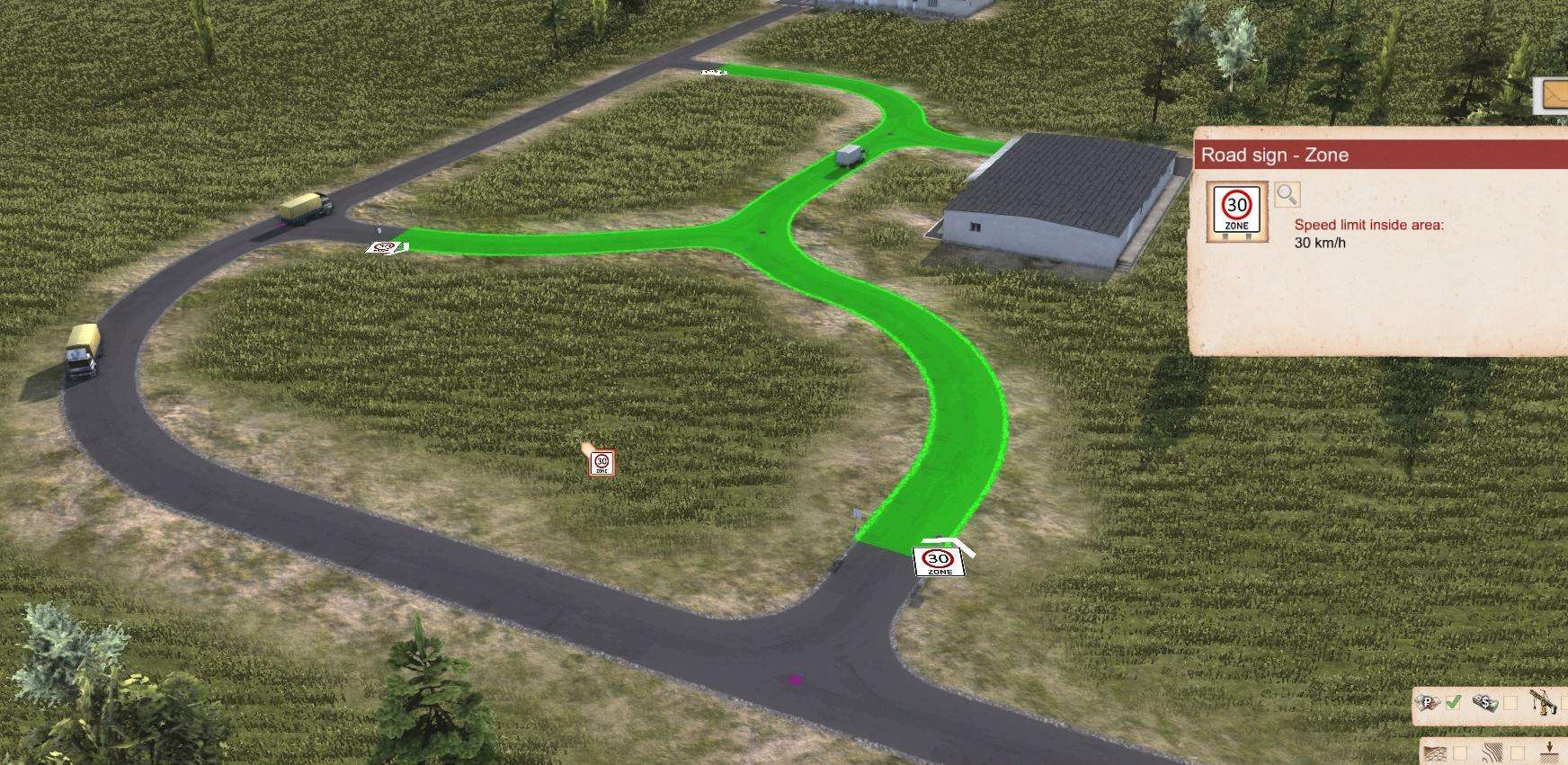
The zone entry signs can be clicked on, to see an overlay of the zone, and see any potential error.
Even if a street is a one-way street leading away from a zone, the zone sign still needs to “point” at the direction of the zone.
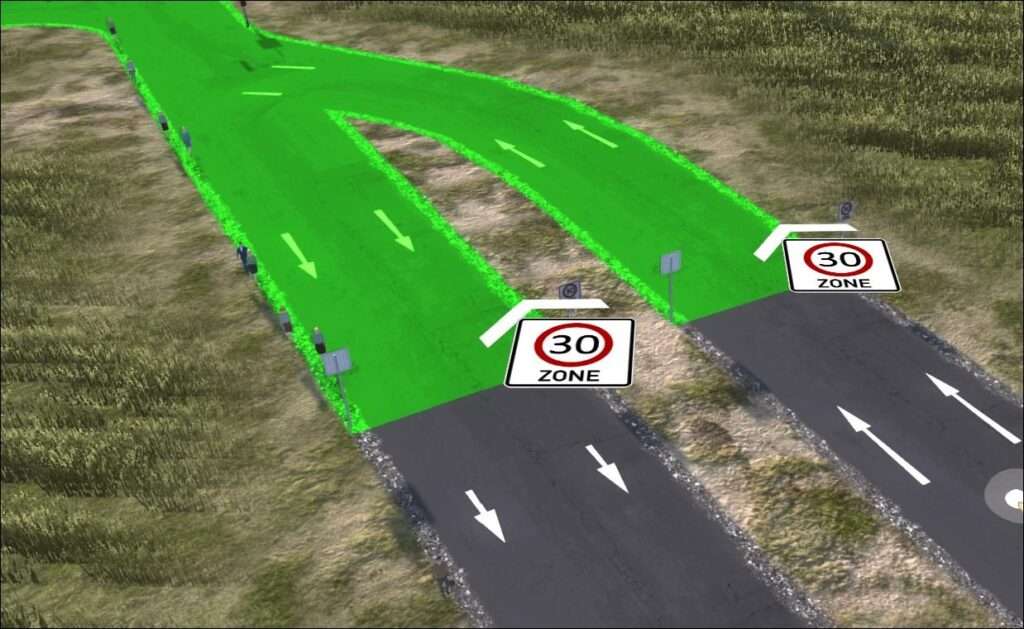
There are two type of zones.
Speed Limit Zones


Speed Limit Zones force vehicles to drive a below the designated speed limit within the zone. The limit can be decreased or increased with Q/E.
City Limits

City Limits is type of zone with a 60km/h speed limit within it’s borders. From observation, it also seems vehicles will try to avoid driving through it, even if it’s faster despite the 60km/h limit.
The City Limits zone is also very nice for role-playing, because they add really neat city limit signs.

Interaction with other signs
If placed within a zone, normal speed limit signs will temporarily over-write the zone’s speed limit. Essentially, think of the zone as the new “default”.
This means if the speed limit sign is higher than the zone, cars will speed up on the following segment. If the speed limit sign is lower than the zone, cars will drive even slower on that street. A “End of Restriction” sign, will only end the speed limit sign, and re-apply the zone’s speed limit.
City Limit Zones and Speed Limit Zones can overlap each other. However, the speed limit zone takes precedent.
This means, you can have Speed Limit Zones inside of the City Limit Zone, and within that zone you can have even shorter normal Speed Limit signs.
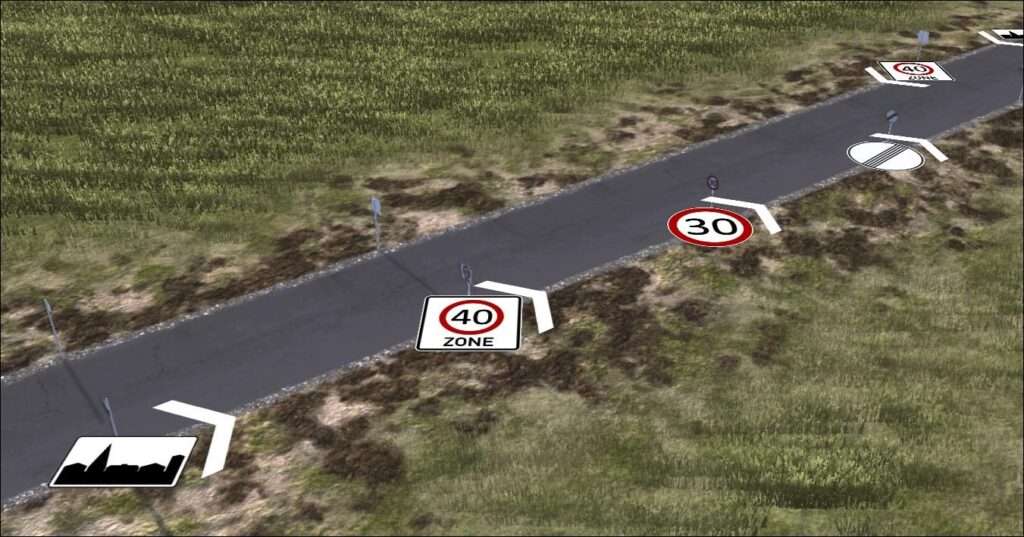
“Yo dawg, I heard you like speed limits, so I put a speed limit on your speed limit, so you can limit your speed while limiting your speed”
Priority Signs & Traffic Lights


Any intersection can be edited by simply clicking on it. However, the quality of the road limits the type of signage that can be applied.
Multiple crossroads can be combined to a larger crossroad, if the space in between them would not make sense to have signage.
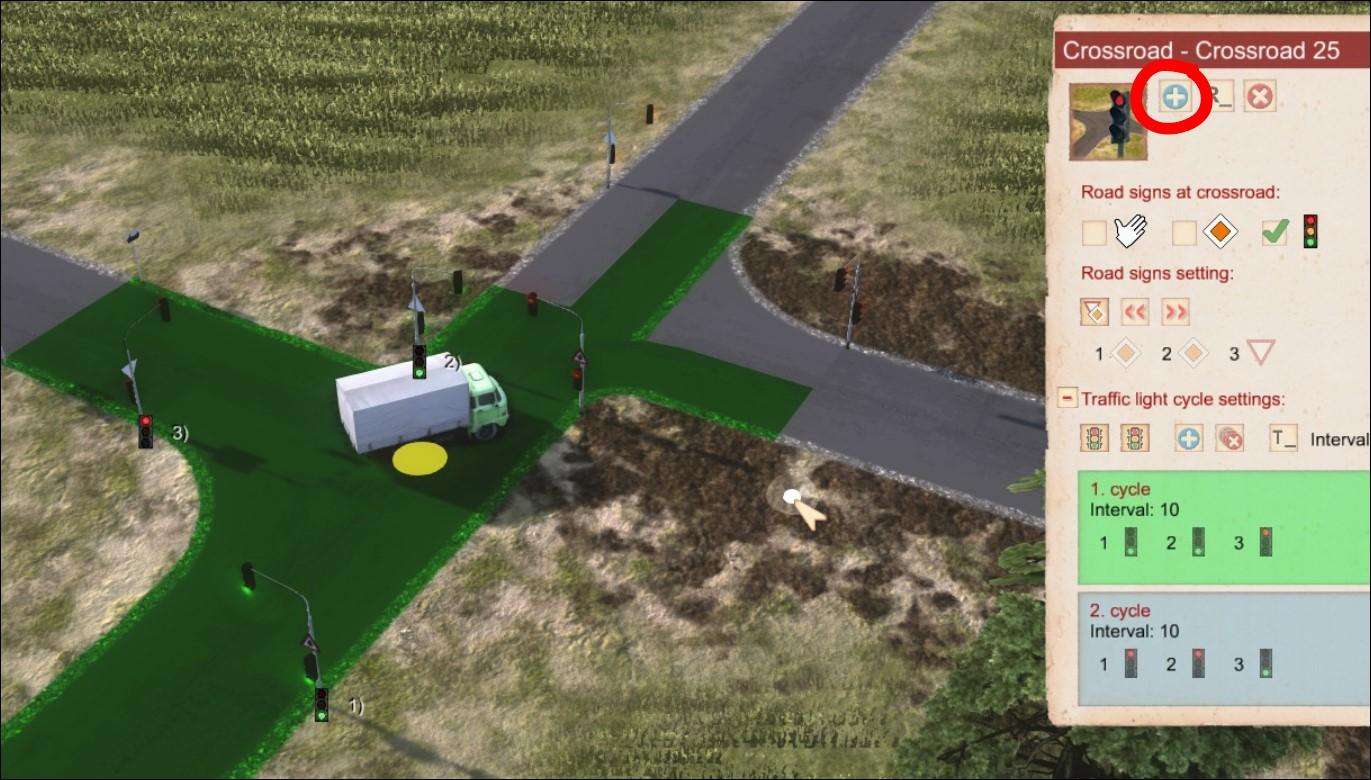

In the top picture, the truck is waiting in the middle of the street, because the 2nd crossroad’s traffic light is red.
In the bottom picture, the two crossroads have been combined into one larger one using the blue + sign. This means the traffic lights are at more sensible places, and the trucks are waiting at appropriate places.
As long as they are nearby, any number of crossings can be combined to a larger one.
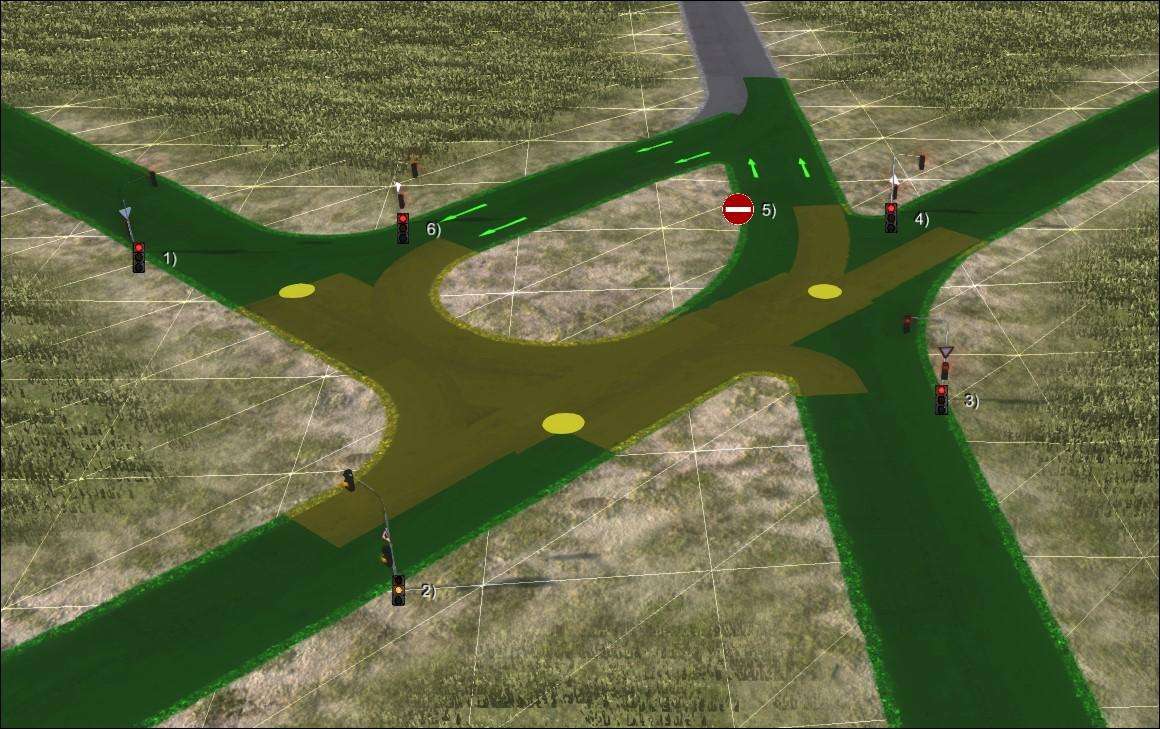
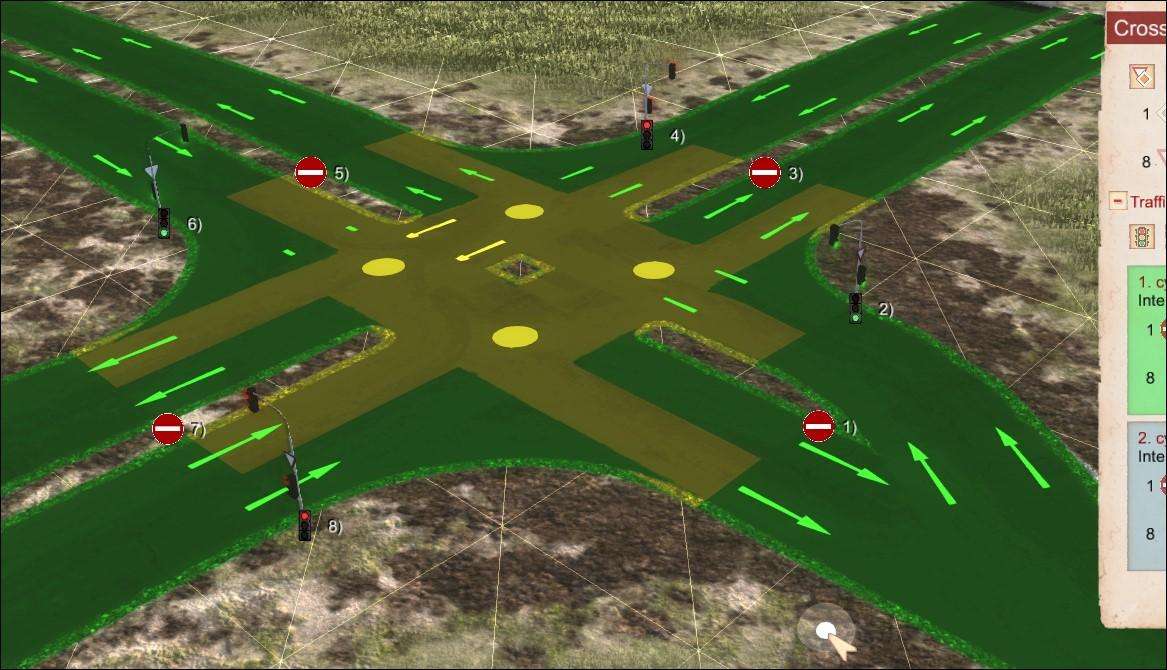
Priority To The Right

Without priority signs, traffic obeys normal Priority To The Right, meaning any vehicle is required to give way to vehicles approaching from the right at intersections.
Priority Signs

Any intersection that at least contains one gravel road, can have Priority Signs added to them.
Priority signs overwrite Priority to the Right. Each road is numbered and correlates to a number in the UI.
An intersection always needs two main roads. This unfortunately means one can not make 4-way stop intersections, although to be fair the reason for those existing in real life is to stop accidents, something that does not exist/matters in WR:SR.
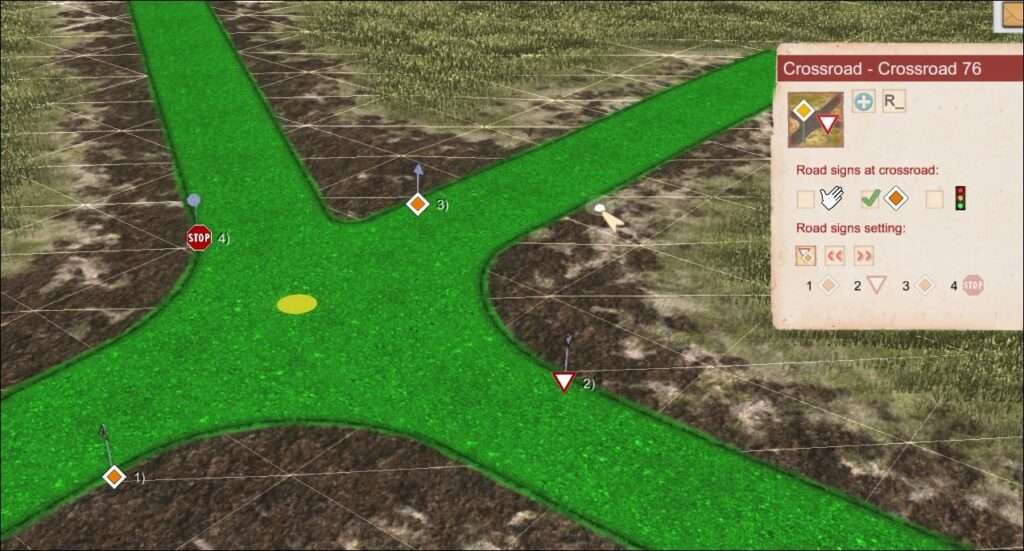
Vehicles heading horizontally have priority. Vehicles coming from the south need to come to a stop if there’s a vehicle on the priority road, but do not stop if there’s no one else. Vehicles coming from the top need to come to a complete stop, no matter if they’re alone or not.
Traffic Lights

Traffic Lights allow a better flow of traffic at dense intersections. An intersection needs to be completely asphalt. Further, if electricity is enabled in the game options, traffic lights need electricity. If there’s no power, the intersection will fall back to priority signs, which also need to be set up for traffic lights.
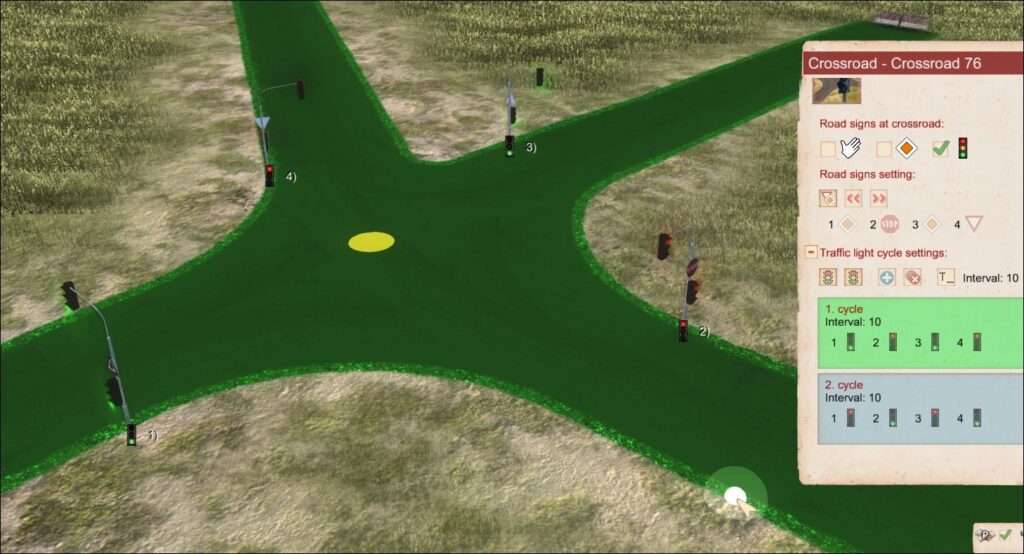
The same four way intersection, with a basic two active green lights setup. The priority signs are still there, in case the electricity goes out.

- A) Generate Pre-made template, where each road has it’s own cycle. Only one light is green, all other lights are red. This means there’ll be as many cycles as there are roads.
- B) Generate Pre-made template, where each cycle tries to have two green lights. This means technically double the throughput, assuming no vehicles drive into each other. If there’s an uneven amount of roads, the last cycle will only have one green light.
- C) Manually add a cycle
- D) Delete all cycles
- E) Set all cycles to this length
A traffic light crossroad is made up of multiple cycles, each cycle being one “setting”. Each cycle can have between zero or two green lights. After the interval, the traffic lights switch to the next cycle, until they’re all done and it loops.
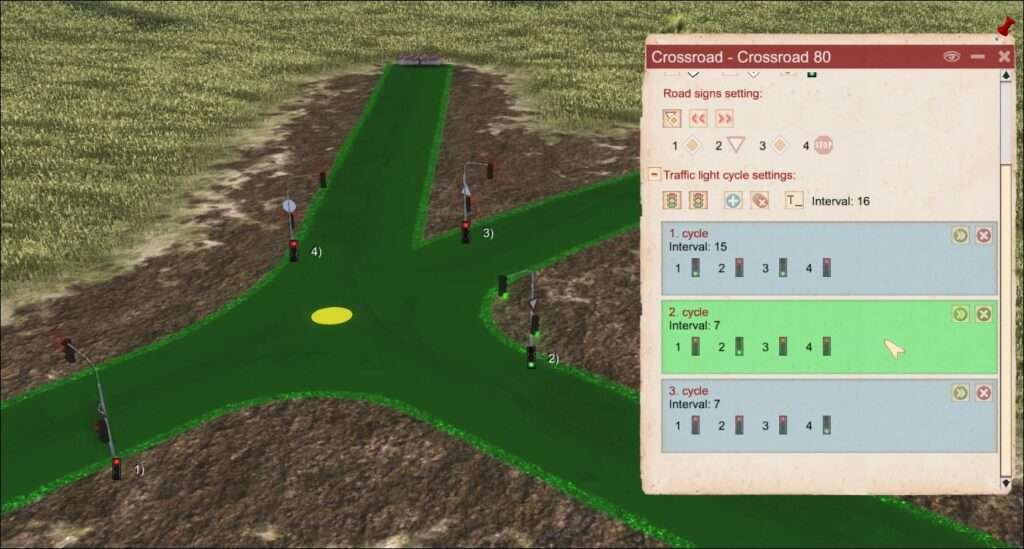
This example has three cycles.
- First cycle: The lights of road 1 and 3 are green, meaning the vehicles in both directions on the main road are allowed to drive. The north road (4) and the southern road (2) are both still red. This lasts for 15 seconds. After 15 seconds:
- Second cycle: The main road is now red (1,3), the north is still red (4), but the southern road (2) can drive. This lasts for 7 seconds.
- Third cycle: Now the north road (4) can finally drive.
- First cycle: North road (4) is back to red, south is red, main road is green again. Since the main road is supposed to have more vehicles, it’s cycle is as long as the other two combined.
There’s no limit to the amount of roads an intersection can have. There’s also no limit to the amount of cycles an intersection can have. And a cycle can even be completely red, if for some reason you just want all the drivers to stare at each other.
One-way streets going off the intersection do not have and do not need lights.
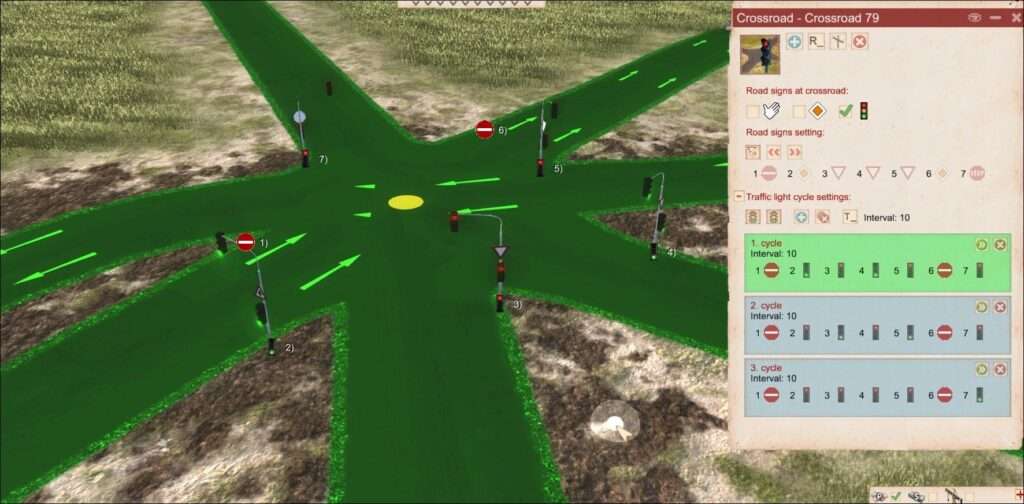
I call this one “the driving instructor’s torture weapon”
Traffic Logic and Conclusion
Traffic Logic
The game’s vehicles obey one rule:
- Find the fastest route I’m allowed to take
Vehicles don’t care about anything else. They don’t care about distance. They do not care about road type. They do not care about traffic.
Further, they only take into consideration their current maximum potential speed. This means, if some truck is fully loaded and can only drive 31km/h, it does not care if the fastest route is a mud road, a gravel road or a high speed one-direction asphalt highway. A vehicle also always has perfect knowledge of what’s ahead and knows the entire route and knows which roads it can take and what their speed limit is.
This means if there’s for example two roads to it’s destination, one going through a town with a 60km/h speed limit zone and even some 40km/h parts, and another road that goes around the town but has no speed limit, most vehicles will figure out going around the town is actually faster. Unless of course, we’re talking about our dumpy big fat truck from earlier, the one that can only drive 31km/h anyways. In it’s case, it might decide to just drive through the village. To prohibit that, one would also need to put “No Heavy Vehicles except Supply” at various parts of the town, potentially even at the entrance of it. Or one could put a Weight Limit sign infront of the town. Or a No Trailers.
The point is that the toolbox is large and diverse enough, that the same problem can be solved in a bunch of different ways. Most of it can be figured out through experimentation.
Like much of this amazing game, there’s no “one correct way” to do things.
Conclusion
Now what can and should you do with it?
Well… that’s really up to you, and the specific problems you are looking to solve at any given time and location.
Traffic lights are great at directing traffic, but a waste of time and electricity on a random rural road that only has one single random truck drive by once every 40 minutes. Even priority signs might be unnecessary in that situation.
At the entrance of a busy industrial area, you could have 3 separate roads leading into it. One for buses and private cars bringing workers, a separate one for the empty trucks, and one for the fully loaded trucks. The car/bus road could have “Heavy Cargo trucks” banned. The road for empty trucks could have a “Weight Limit” of 7t, which is exactly the LZ100 dumper semi-trailer truck, meaning any one of those with a full load would be banned from it. And the road for the full trucks, could have the “No Overtaking” sign alongside a “Speed Limit” of 50km/h, so the heavy fully loaded trucks are left alone and not interrupted.

(Looking at it, one could even further optimize it by switching the two truck roads, since the empty ones are crossing the path of the full ones. Further, in this screenshot, there are no full ones heading towards the area and leaving empty)
You can have a large downtown area, which is part of a Speed Limit 40 zone, but has one large road going through it with a speed limit of 70. Meanwhile, all the side roads have the “No Heavy Cargo except Supplies”. And also, pedestrians are banned from just walking all over the fast road, and instead are told to use the safe bridges.
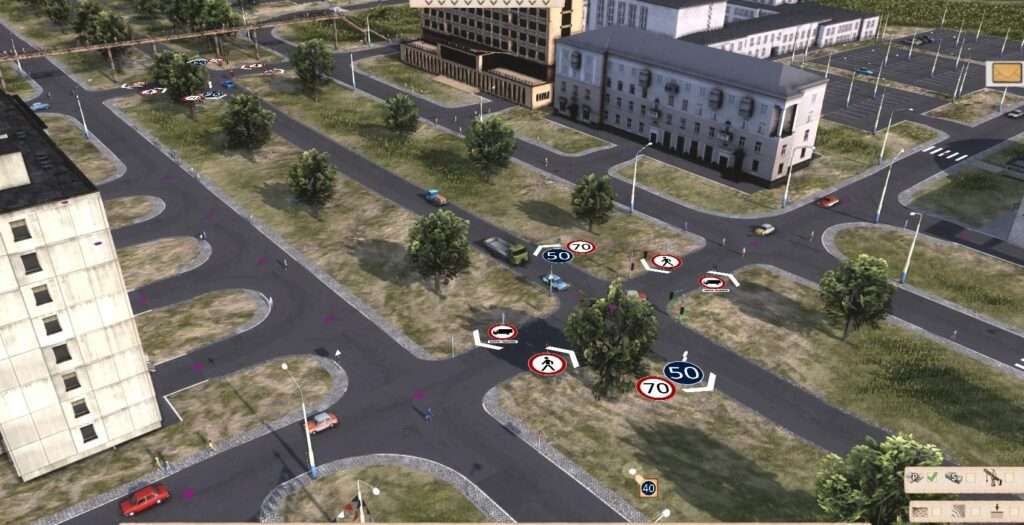
You can have one Distribution Office take from two different cargo station, one of the two is exclusive for smaller trucks, while the large trailer trucks are bound to the other one. This means the two types of trucks won’t clog each other up when picking up goods, but they’re still part of the same distribution office and can deliver to the same customers.
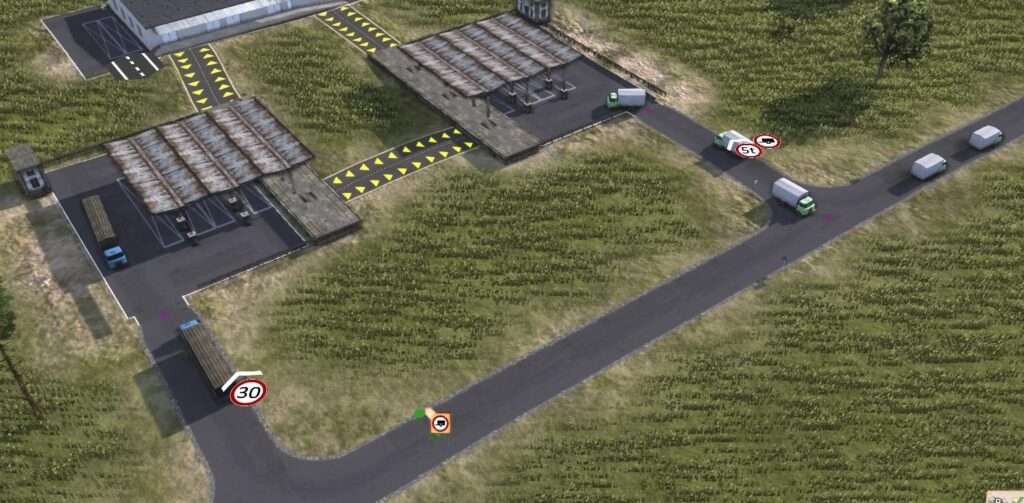
If you can think of any other interesting ways to use the traffic toolbox, do not hesitate to share it.


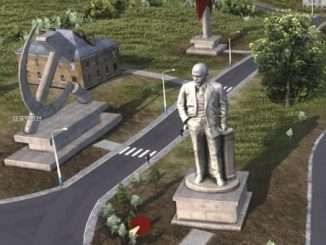
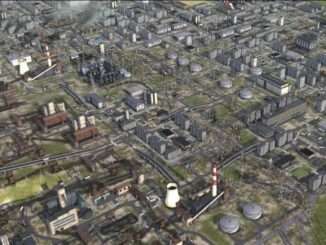
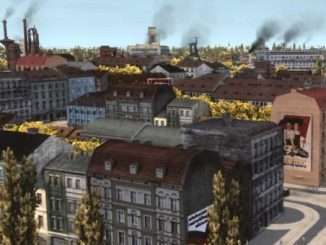
Thanks for a great guide! Loved the practical examples and a sense of humour sprinkled in ?
Very well-made guide